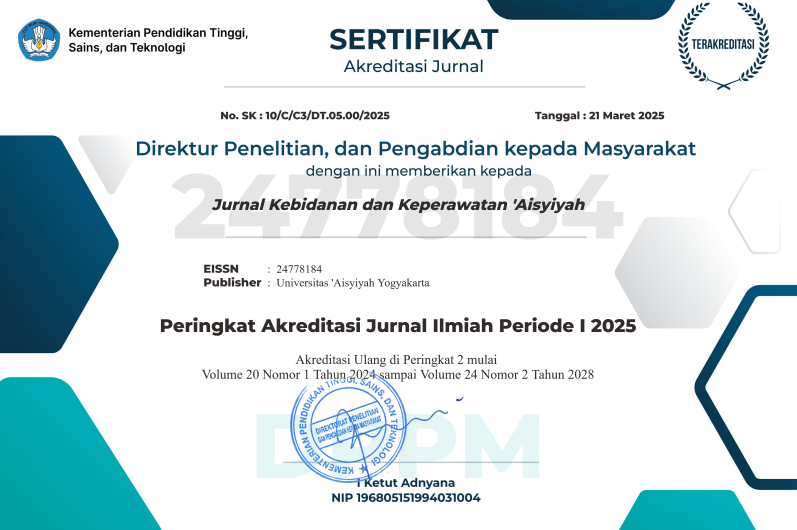Design of BWAT method development in diabetic foot ulcers patients in hospital: Action research
DOI:
https://doi.org/10.31101/jkk.3031Abstract views 859 times
Keywords:
BWAT, diabetic foot ulcers, diabetes mellitus, wound assesmentAbstract
Downloads
References
Abdissa, D., Adugna, T., Gerema, U., & Dereje, D. (2020). Prevalence of Diabetic Foot Ulcer and Associated Factors among Adult Diabetic Patients on Follow-Up Clinic at Jimma Medical Center, Southwest Ethiopia, 2019: An Institutional-Based Cross-Sectional Study. Journal of Diabetes Research, 2020, 4106383. https://doi.org/10.1155/2020/4106383
Alosaimi, F. D., Labani, R., Almasoud, N., Alhelali, N., Althawadi, L., & AlJahani, D. M. (2019). Associations of foot ulceration with quality of life and psychosocial determinants among patients with diabetes; a case-control study. Journal of Foot and Ankle Research, 12(1), 57. https://doi.org/10.1186/s13047-019-0367-5
Armstrong, D. G., Boulton, A. J. M., & Bus, S. A. (2017). Diabetic Foot Ulcers and Their Recurrence. The New England Journal of Medicine, 376(24), 2367–2375. https://doi.org/10.1056/NEJMra1615439
Ausserhofer, D., Rakic, S., Novo, A., Dropic, E., Fisekovic, E., Sredic, A., & Van Malderen, G. (2016). Improving the safety and quality of nursing care through standardized operating procedures in Bosnia and Herzegovina. International Nursing Review, 63(2), 208–217. https://doi.org/10.1111/inr.12237
Barbé, B., Verdonck, K., Mukendi, D., Lejon, V., Kalo, J.-R. L., Alirol, E., Gillet, P., Horié, N., Ravinetto, R., Bottieau, E., Yansouni, C., Winkler, A. S., Loen, H. van, Boelaert, M., Lutumba, P., & Jacobs, J. (2016). The Art of Writing and Implementing Standard Operating Procedures (SOPs) for Laboratories in Low-Resource Settings: Review of Guidelines and Best Practices. PLOS Neglected Tropical Diseases, 10(11), e0005053. https://doi.org/10.1371/journal.pntd.0005053
Bates-Jensen, B. M., McCreath, H., Patlan, A., & Harputlu, D. (2019). Reliability of the Bates-Jensen Wound Assessment Tool (BWAT) for Pressure Injury Assessment: The Pressure Ulcer Detection Study. Wound Repair and Regeneration : Official Publication of the Wound Healing Society [and] the European Tissue Repair Society, 27(4), 386–395. https://doi.org/10.1111/wrr.12714
Bekele, F., & Chelkeba, L. (2020). Amputation rate of diabetic foot ulcer and associated factors in diabetes mellitus patients admitted to Nekemte referral hospital, western Ethiopia: Prospective observational study. Journal of Foot and Ankle Research, 13(1), 65. https://doi.org/10.1186/s13047-020-00433-9
Blacius dedi. (2021). Buku metodologi penelitian kualitatif dalam keperawatan (B. Dedi, Ed.; 2021st ed.). Universitas karya HusadaSemarang.
Greatrexâ€White, S., & Moxey, H. (2013). Wound assessment tools and nurses’ needs: An evaluation study. International Wound Journal, 12(3), 293–301. https://doi.org/10.1111/iwj.12100
Hicks, C. W., Canner, J. K., Mathioudakis, N., Lippincott, C., Sherman, R. L., & Abularrage, C. J. (2020). Incidence and Risk Factors Associated With Ulcer Recurrence Among Patients With Diabetic Foot Ulcers Treated in a Multidisciplinary Setting. The Journal of Surgical Research, 246, 243–250. https://doi.org/10.1016/j.jss.2019.09.025
IDF. (2021). Indonesia diabetes report 2000—2045. https://www.diabetesatlas.org/data/en/country/94/id.html
Jais, S., & Pratama, K. (2023). A diabetic foot wound healing assessment tool: A scoping review. Heliyon, 9(5), e15736. https://doi.org/10.1016/j.heliyon.2023.e15736
Jørgensen, L. B., Sørensen, J. A., Jemec, G. B., & Yderstraede, K. B. (2016). Methods to assess area and volume of wounds—A systematic review. International Wound Journal, 13(4), 540–553. https://doi.org/10.1111/iwj.12472
Jupiter, D. C., Thorud, J. C., Buckley, C. J., & Shibuya, N. (2016). The impact of foot ulceration and amputation on mortality in diabetic patients. I: From ulceration to death, a systematic review. International Wound Journal, 13(5), 892–903. https://doi.org/10.1111/iwj.12404
Karahan, A., AAbbasoğlu, A., Işık, S. A., Çevik, B., Saltan, Ç., Elbaş, N. Ö., & Yalılı, A. (2018). Factors Affecting Wound Healing in Individuals With Pressure Ulcers: A Retrospective Study. Ostomy/Wound Management, 64(2), 32–39.
Khan, M. A. B., Hashim, M. J., King, J. K., Govender, R. D., Mustafa, H., & Al Kaabi, J. (2020). Epidemiology of Type 2 Diabetes – Global Burden of Disease and Forecasted Trends. Journal of Epidemiology and Global Health, 10(1), 107–111. https://doi.org/10.2991/jegh.k.191028.001
Lin, C., Liu, J., & Sun, H. (2020). Risk factors for lower extremity amputation in patients with diabetic foot ulcers: A meta-analysis. PLOS ONE, 15(9), e0239236. https://doi.org/10.1371/journal.pone.0239236
Lo, Z. J., Surendra, N. K., Saxena, A., & Car, J. (2021). Clinical and economic burden of diabetic foot ulcers: A 5â€year longitudinal multiâ€ethnic cohort study from the tropics. International Wound Journal, 18(3), 375–386. https://doi.org/10.1111/iwj.13540
Malyar, N. M., Freisinger, E., Meyborg, M., Lüders, F., Gebauer, K., Reinecke, H., & Lawall, H. (2016). Amputations and mortality in in-hospital treated patients with peripheral artery disease and diabetic foot syndrome. Journal of Diabetes and Its Complications, 30(6), 1117–1122. https://doi.org/10.1016/j.jdiacomp.2016.03.033
Ousey, K., & Cook, L. (2012). Wound Assessment: Made Easy. Wounds UK, 8.
Pemayun, T. G. D., & Naibaho, R. M. (2017). Clinical profile and outcome of diabetic foot ulcer, a view from tertiary care hospital in Semarang, Indonesia. Diabetic Foot & Ankle, 8(1), 1312974. https://doi.org/10.1080/2000625X.2017.1312974
Perrin, B. M., van Netten, J. J., aan de Stegge, W. B., Busch-Westbroek, T. E., & Bus, S. A. (2022). Health-related quality of life and associated factors in people with diabetes at high risk of foot ulceration. Journal of Foot and Ankle Research, 15(1), 83. https://doi.org/10.1186/s13047-022-00586-9
Petersen, B. J., Rothenberg, G. M., Lakhani, P. J., Zhou, M., Linders, D. R., Bloom, J. D., Wood, K. A., & Armstrong, D. G. (2020). Ulcer metastasis? Anatomical locations of recurrence for patients in diabetic foot remission. Journal of Foot and Ankle Research, 13(1), 1. https://doi.org/10.1186/s13047-020-0369-3
Raghav, A., Khan, Z. A., Labala, R. K., Ahmad, J., Noor, S., & Mishra, B. K. (2018). Financial burden of diabetic foot ulcers to world: A progressive topic to discuss always. Therapeutic Advances in Endocrinology and Metabolism, 9(1), 29–31. https://doi.org/10.1177/2042018817744513
Rasyid, N., Yusuf, S., & Tahir, T. (2019). Interrater Reliability Dan Internal Consistency Pengkajian Luka Kaki Diabetik the New Diabetic Foot Ulcer Assessment Scale (Dfuas) Berbasis Foto. Jurnal Kesehatan Manarang, 5(1), 19. https://doi.org/10.33490/jkm.v5i1.82
Rodrigues, B. T., Vangaveti, V. N., & Malabu, U. H. (2016). Prevalence and Risk Factors for Diabetic Lower Limb Amputation: A Clinic-Based Case Control Study. Journal of Diabetes Research, 2016, 5941957. https://doi.org/10.1155/2016/5941957
Schaper, N. C., Van Netten, J. J., Apelqvist, J., Lipsky, B. A., Bakker, K., & International Working Group on the Diabetic Foot. (2016). Prevention and management of foot problems in diabetes: A Summary Guidance for Daily Practice 2015, based on the IWGDF Guidance Documents. Diabetes/Metabolism Research and Reviews, 32 Suppl 1, 7–15. https://doi.org/10.1002/dmrr.2695
Shestopalova, T. N., & Gololobova, T. V. (2018). Standard operating procedures as a trend in ensuring healthcare safety. Health Risk Analysis, 2018, 129–137. https://doi.org/10.21668/health.risk/2018.2.15.eng
Sukmana, M., Sianturi, R., Sholichin, S., & Aminuddin, M. (2020). Pengkajian Luka Menurut Meggit-Wagner dan Pedis Pada Pasien Ulkus Diabetikum. Jurnal Kesehatan Pasak Bumi Kalimantan, 2(2), 79–88.
Sun, H., Saeedi, P., Karuranga, S., Pinkepank, M., Ogurtsova, K., Duncan, B. B., Stein, C., Basit, A., Chan, J. C. N., Mbanya, J. C., Pavkov, M. E., Ramachandaran, A., Wild, S. H., James, S., Herman, W. H., Zhang, P., Bommer, C., Kuo, S., Boyko, E. J., & Magliano, D. J. (2022). IDF Diabetes Atlas: Global, regional and country-level diabetes prevalence estimates for 2021 and projections for 2045. Diabetes Research and Clinical Practice, 183, 109119. https://doi.org/10.1016/j.diabres.2021.109119
Vanneste, D., De Almeida Mello, J., Macq, J., Van Audenhove, C., & Declercq, A. (2015). Incomplete Assessments: Towards a Better Understanding of Causes and Solutions. The Case of the interRAI Home Care Instrument in Belgium. PLoS ONE, 10(4), e0123760. https://doi.org/10.1371/journal.pone.0123760
Walker, C. A., Rahman, A., Gipson-Jones, T. L., & Harris, C. M. (2019). Hospitalists’ Needs Assessment and Perceived Barriers in Wound Care Management: A Quality Improvement Project. Journal of Wound, Ostomy, and Continence Nursing : Official Publication of The Wound, Ostomy and Continence Nurses Society, 46(2), 98–105. https://doi.org/10.1097/WON.0000000000000512
Walsh, J. W., Hoffstad, O. J., Sullivan, M. O., & Margolis, D. J. (2016). Association of diabetic foot ulcer and death in a population-based cohort from the United Kingdom. Diabetic Medicine: A Journal of the British Diabetic Association, 33(11), 1493–1498. https://doi.org/10.1111/dme.13054
Yani, N. I. I. (2017). Uji Insrtument Time modifikasi Bates Jensen metode checklist di RSUD Prof.Dr.Margono Soekarjo Purwokerto. Fakultas Ilmu Kesehatan , UMP.
Yusuf, S., Okuwa, M., Irwan, M., Rassa, S., Laitung, B., Thalib, A., Kasim, S., Sanada, H., Nakatani, T., & Sugama, J. (2016). Prevalence and Risk Factor of Diabetic Foot Ulcers in a Regional Hospital, Eastern Indonesia. Open Journal of Nursing, 06(01), 1–10. https://doi.org/10.4236/ojn.2016.61001
Zufry, H. (2018). Lama Rawatan dan Direct Cost Pasien Kaki Diabetik Teramputasi di RS Dr. Zainoel Abidin Banda Aceh: Pre-Eliminary Study. AVERROUS: Jurnal Kedokteran dan Kesehatan Malikussaleh, 4(1), 81. https://doi.org/10.29103/averrous.v4i1.807
Downloads
Additional Files
Published
How to Cite
Issue
Section
License
With the receipt of the article by the Jurnal Kebidanan dan Keperawatan Aisyiyah Editorial Board and the decision to be published, then the copyright regarding the article will be diverted to Jurnal Kebidanan dan Keperawatan Aisyiyah. Universitas 'Aisyiyah Yogyakarta as the publisher of Jurnal Kebidanan dan Keperawatan Aisyiyah hold the copyright regarding all the published articles in this journal.
Jurnal Kebidanan dan Keperawatan Aisyiyah is licensed under a Creative Commons Attribution-ShareAlike 4.0 International License.
















